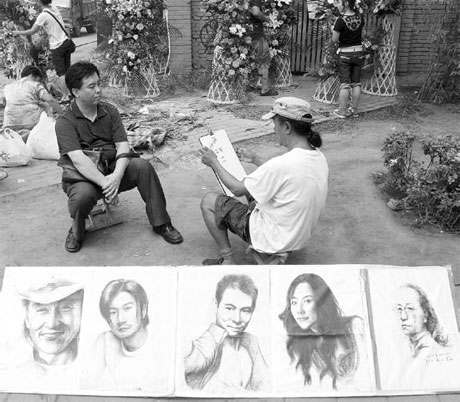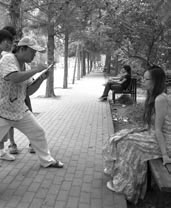Life and Leisure
Brush with destiny
By Cai Xiao (China Daily)
Updated: 2010-10-04 10:39
 |
Large Medium Small |
|
A street artist does a portrait for a visitor at the 798 Art Zone in Beijing. Photos by Jiang Dong / China Daily |
Capital's premier art district is attracting hordes of painters from far-flung provinces who hope to make it big in nation's red hot art scene, Cai Xiao reports
Amid the vendors and street painters on the road leading to the gallery hub of the 798 Art District, one young man stands out.
Wearing long hair, he occupies a spot some 200 meters from the entrance and has a bigger crowd around him than the others.
Unlike them, this well-built man does his portraits standing, striking a kungfu-like pose as if ready to spring into action.
As he hands over a portrait to a young girl, those who have been watching his antics with barely-concealed mirth, burst into hearty laughter and give him their thumbs-up.
He is Cha Peng, one of the many street artists who are adding a new dimension to the capital's premier art zone, that was founded in the 1990s.
The ordnance factory-turned-artist community is widely known both at home and abroad for its vibrant contemporary art scene.
Riding on intense media exposure, it has become one of the capital's popular tourist destinations, reportedly attracting 1.5 million tourists every year.
Increasingly, it is also attracting street artists like Cha to come and seek their fortunes.
"They have already gained a foothold in this hotbed of contemporary Chinese art," says Liu Gang, deputy director of the Beijing 798 Art Zone Administration & Development Office.
However, these artists have had to travel a long way to get this foothold.
|
Cha Peng, one of the street artists at 798, strikes a kungfu-like pose while painting. |
"We could have led a cozy life back home," says Jin Yuanhua. "Our lives changed when we began to chase our dreams Some even called us nuts."
Cha was one of the first street artists to descend on the 798 Art Zone.
The 33-year-old developed a strong interest in caricature when he was a middle-school student. He was later trained at a local art college and has been in Beijing for years, doing various odd jobs. But his dream has always been to "become a professional artist".
Cha's passion and skills draw many customers helping him make about 5,000 yuan ($735) a month, much higher than what the others make.
Jin Yuanhua used to own an art studio in Shiyan, in Hubei province, but his family did not support his artistic aspirations. The sculptor eventually moved to Beijing.
Soon after he arrived in the big city, he lost all his money in a public bathhouse. He tried many different jobs but did not make it anywhere, and once even thought of taking his life.
"I have come here in pursuit of a dream; and every dream demands a price," Jin says philosophically.
Wang Shixue once worked as an art director at Jilin Paper Mill. He had his own studio and his works were well appreciated.
But at 50, the factory closed shop.
All his attempts to find a new job were met with rejections. He was told he was "too old and unskilled".
Wandering around like a vagabond for eight years, he finally moved to Beijing.
Lin Feng, the only university student among the street artists, used to work in a training company.
"My dream job is to be an art teacher or comics designer," he says with a smile.
But he knows he has a bumpy ride ahead.
The young artist says he can only afford to rent a room of less than 20 square meters, in nearby villages such as Feijiacun village.
Every month, he needs to pay at least 600-700 yuan ($88-103) in rent.
Most street artists, he says, work from 9 am to 6 pm, seven days a week. Wang Shixue, a 58-year-old man, puts in 12 hours a day.
Every caricature a street artist does earns 20 yuan ($2.9) and every sketch, 30 yuan ($4.4); small figure sculptures bring in 300 ($44) yuan.
"Earnings vary from day to day," Lin says, "But weekends are our golden time."
Despite all the difficulties, the street artists agree that the 798 Art Zone "is an artists' haven to hang around, at least for the time being".
Wang says, he often visits the housed exhibitions in 798.
So does Jin.
But neither envies the artists whose works sell well in the galleries.
Speaking of their future, Jin hopes "someday someone who appreciates my talent will invite me 'to undertake large projects'."
Voicing similar ambitions Cha says: "After my wife and I settle down, I hope to hold an exhibition of my works."
Li Chunhua, an artist at 798 who has watched these street artists over the months, says they remind him of the painters in Montmartre, in the north of Paris, a cradle for such big-name artists as Pablo Picasso and Vincent van Gogh.
"When I used to walk on the streets of Montmartre, I felt so inspired by the artists there. Their eyes expressed the ideals that guided their inspirations," he says.
But the 798 street painters, he says, "are really simply struggling to earn a living".

